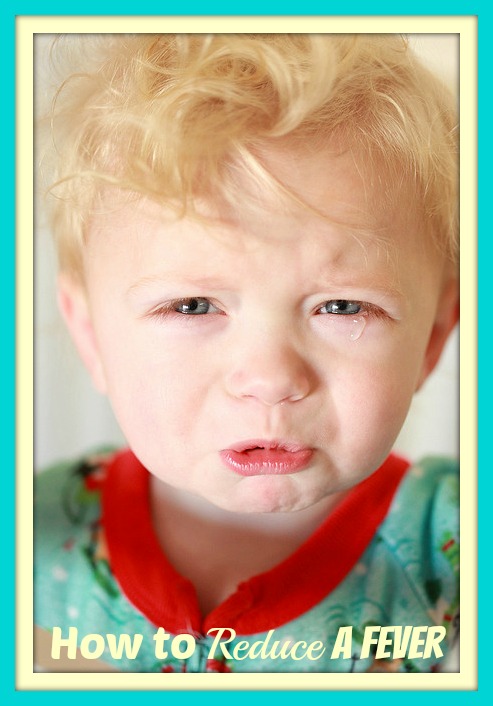How to Reduce Your Child’s Fever.
It can be scary when your child has a fever. You start worrying about all the possible scenarios of WHY your child has a fever. Is it something serious? Should I take my child to the doctor? Can I WAIT to take my child to the doctor? How do I reduce my child’s fever?!?!
I’ve been a Registered Nurse for 8 years with most my experience in Pediatrics. First, let me clarify that fevers are NOT necessarily a bad thing. Fever is the bodies natural way of fighting off unwanted bacteria and viruses. Your intelligent body knows by increasing its temperature it slows down the growth of foreign bacteria and viruses. This gives your immune system a fighting chance to kill them off! I can’t emphasize this enough… fever ALONE is NOT a reason to take your child to the doctor or emergency room!
When my friends and family call and ask whether or not to take their feverish child to the doctor, these are the guidelines I share with them. These guidelines are for children older than 3 MONTHS OLD. You should notify your pediatrician immediately if your child younger than 3 months old has a fever.
If your child has a fever WITH the following symptoms, then it’s time to call your pediatrician or take your child to the emergency room:
- 1) A severe loss of appetite. None of us feel like eating much when we’re not feeling 100%. So, it’s okay if your child doesn’t have much of an appetite. The most important thing is that your child is drinking fluids (popsicles and slushies do count as fluid intake). If your child is refusing to drink or eat AND has signs of dehydration (check out #2 below), notify your pediatrician or take your child to the emergency room.
- 2) Signs of dehydration include little or no urine, dark yellow urine, decrease in wet diapers, lethargy (sluggish, fatigued, deep sleep), dry mouth, or no tears when crying.
- 3) Productive cough which means your child is coughing up mucus or blood.
- 4) Nausea or vomiting.
- 5) Thick, yellow or green nasal drainage.
- 6) Signs of an ear infection such as ear pain or pressure, thick yellow or bloody ear drainage, trouble hearing, or dizziness.
- 7) An unexplained rash.
- 8) Difficulty breathing. Is your child breathing faster than normal? Do they appear to be struggling to breath? Any change in skin color around their lips (pale, bluish, or grayish tones)?
- 9) A wound, bug bite, or injury site that is red, swollen, warm to touch, or has pussy drainage.
- 10) Ultimately, you are the parent or guardian. You know your child best. If you feel uneasy about their condition or notice an extreme change in behavior, notify your pediatrician.
There are several methods to reduce your child’s fever at home. Here are a few ways to reduce your child’s fever:
- 1) Acetaminophen every 4 to 6 hours. Here’s a great chart on acetaminophen dosages. DO NOT give acetaminophen to children younger than 3 months old without talking to your pediatrician first.
- 2) Ibuprofen every 6 to 8 hours. Here’s also a great chart on ibuprofen dosages. DO NOT give ibuprofen to children younger than 6 months old without talking to your pediatrician first.
- 3) DO NOT overdress or put several blankets on your child. It will actually cause the fever to increase. If anything, you may want to shed some layers.
- 4) Have your child bathe or shower in warm water. DO NOT have them use extreme hot or cold water temperatures.
- 5) Put a cool, wet washcloth on their forehead and/or chest.
- 6) Like I mentioned above, fluid intake is extremely important! If they’re refusing water, juice or milk, try popsicles, slushies, herbal tea, chicken or beef broth.
- 7) Rest. Let your child watch a few movies, read some books, and play some games. If they are bouncing around and have enough energy to tease their siblings, I think they’re just fine.
Again, you are the parent and guardian and know your child best. If you have a ‘gut feeling’ something is wrong, LISTEN and take your child to the doctor or emergency room. However, if your child only has a fever without any other symptoms listed above, reduce your child’s fever with the above methods to keep your child comfortable. It’s never fun for caretaker or child to be under the weather… here’s to hoping your little man or lady gets feeling better quickly!


Wow, that’s interesting! I never knew that fevers weren’t necessarily a bad thing and that it was the bodies way of slowing down the bacteria and such. This is such great information. PINNING… [for someday when I hope to have a baby] 🙂
Thanks, Yvonne! I can’t wait for a little ‘Tried and Tasty’ baby to come along.
Thanks for the reminders! I am pinning this for future reference!
Thanks, Amber! Unfortunately all us moms will need this for our future under-the-weather kiddos.
Thanks – I will let my kids have a fever for a bit because I know it is there body fighting infection. If it gets too high or uncomfortable out come the meds and cool washcloths – love all of your ideas!
Thanks, Summer! I think it’s smart to only treat fevers when they get too uncomfortable.
Great tips! Definitely bookmarking this for future reference. Thanks!
Thanks, Cambria! Please come visit again soon.